ESP SKODA YETI 2010 1.G / 5L Service Manual
[x] Cancel search | Manufacturer: SKODA, Model Year: 2010, Model line: YETI, Model: SKODA YETI 2010 1.G / 5LPages: 271, PDF Size: 14.71 MB
Page 183 of 271
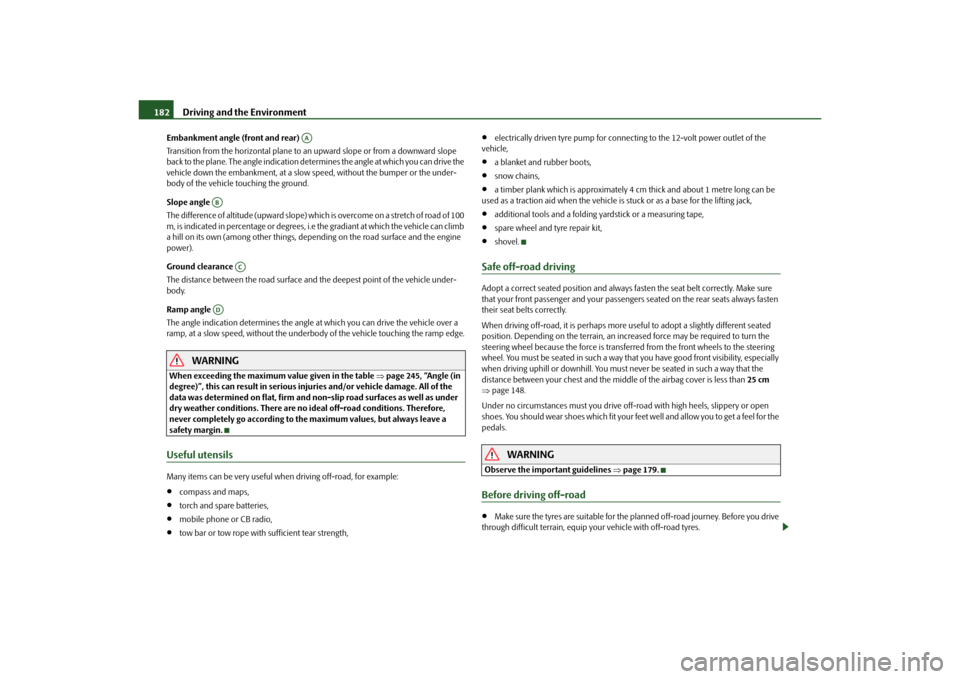
Driving and the Environment
182
Embankment angle (front and rear)
Transition from the horizontal plane to an upward slope or from a downward slope
back to the plane. The angle indication determines the angle at which you can drive the
vehicle down the embankment, at a slow speed, without the bumper or the under-
body of the vehicle touching the ground.
Slope angle
The difference of altitude (upward slope) which is overcome on a stretch of road of 100
m, is indicated in percentage or degrees, i. e the gradiant at which the vehicle can climb
a hill on its own (among other things, depe nding on the road surface and the engine
power).
Ground clearance
The distance between the road surface and the deepest point of the vehicle under-
body.
Ramp angle
The angle indication determines the angle at which you can drive the vehicle over a
ramp, at a slow speed, without the underbody of the vehicle touching the ramp edge.
WARNING
When exceeding the maximum value given in the table page 245, “Angle (in
degree)”, this can result in serious inju ries and/or vehicle damage. All of the
data was determined on flat, firm and no n-slip road surfaces as well as under
dry weather conditions. There are no id eal off-road conditions. Therefore,
never completely go according to the maximum values, but always leave a
safety margin.Useful utensilsMany items can be very useful wh en driving off-road, for example:
compass and maps,
torch and spare batteries,
mobile phone or CB radio,
tow bar or tow rope with sufficient tear strength,
electrically driven tyre pump for connect ing to the 12-volt power outlet of the
vehicle,
a blanket and rubber boots,
snow chains,
a timber plank which is approximately 4 cm thick and about 1 metre long can be
used as a traction aid when the vehicle is stuck or as a base for the lifting jack,
additional tools and a folding yardstick or a measuring tape,
spare wheel and tyre repair kit,
shovel.
Safe off-road drivingAdopt a correct seated position and always fa sten the seat belt correctly. Make sure
that your front passenger and your passengers seated on the rear seats always fasten
their seat belts correctly.
When driving off-road, it is perhaps more useful to adopt a slightly different seated
position. Depending on the terrain, an incr eased force may be required to turn the
steering wheel because the force is transferred from the front wheels to the steering
wheel. You must be seated in such a way that you have good front visibility, especially
when driving uphill or downhill. You must never be seated in such a way that the
distance between your chest and the midd le of the airbag cover is less than 25 cm
page 148.
Under no circumstances must you drive off-ro ad with high heels, slippery or open
shoes. You should wear shoes which fit your feet well and allow you to get a feel for the
pedals.
WARNING
Observe the important guidelines page 179.Before driving off-road
Make sure the tyres are suitable for the pl anned off-road journey. Be fore you dri ve
through difficult terrain, equip yo ur vehicle with off-road tyres.
AA
AB
AC
AD
s2ug.6.book Page 182 Friday, April 9, 2010 2:24 PM
Page 184 of 271
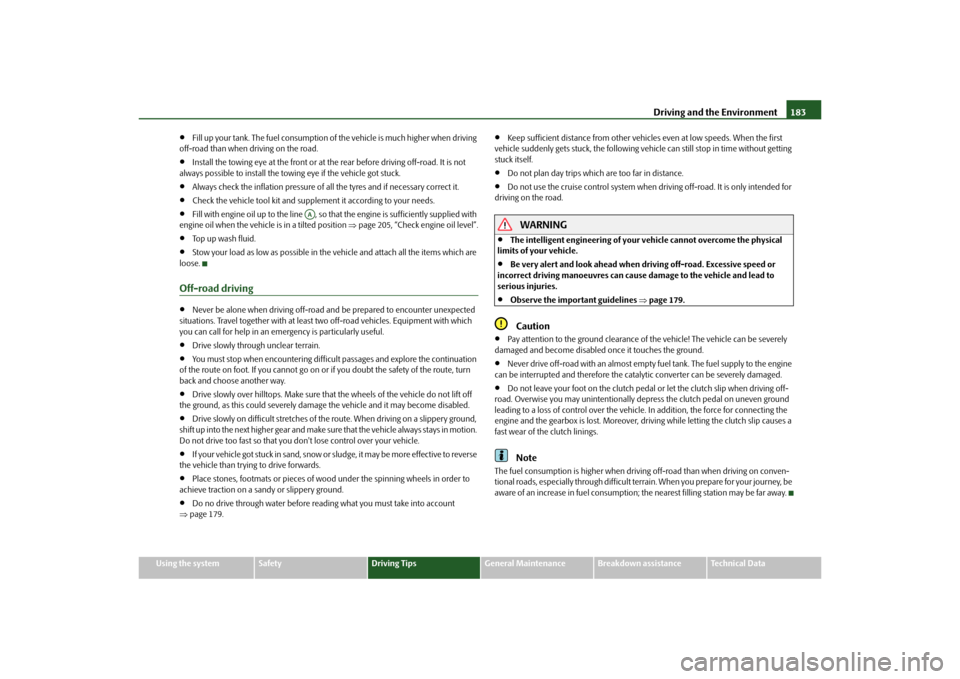
Driving and the Environment183
Using the system
Safety
Driving Tips
General Maintenance
Breakdown assistance
Technical Data
Fill up your tank. The fuel consumption of the vehicle is much higher when driving
off-road than when driving on the road.
Install the towing eye at the front or at the rear before driving off-road. It is not
always possible to install the towing eye if the vehicle got stuck.
Always check the inflation pressure of a ll the tyres and if necessary correct it.
Check the vehicle tool kit and supplement it according to your needs.
Fill with engine oil up to the line , so that the engine is sufficiently supplied with
engine oil when the vehicle is in a tilted position page 205, “Check engine oil level”.
Top up wash fluid.
Stow your load as low as possible in th e vehicle and attach all the items which are
loose.
Off-road driving
Never be alone when driving off-road and be prepared to encounter unexpected
situations. Travel together with at least two off-road vehicles. Equipment with which
you can call for help in an emer gency is particularly useful.
Drive slowly through unclear terrain.
You must stop when encountering difficul t passages and explore the continuation
of the route on foot. If you cannot go on or if you doubt the safety of the route, turn
back and choose another way.
Drive slowly over hilltops. Ma ke sure that the wheels of the vehicle do not lift off
the ground, as this could severely damage the vehicle and it may become disabled.
Drive slowly on difficult stretches of the route. When driving on a slippery ground,
s h i f t u p i n to t h e n e xt h i g h e r g e a r a n d m a ke s u re t h a t t he v e h i c l e a l w a y s s t a y s i n m o t i o n.
Do not drive too fast so that you do n't lose control over your vehicle.
If your vehicle got stuck in sand, snow or sludge, it may be more effective to reverse
the vehicle than trying to drive forwards.
Place stones, footmats or pieces of wood under the spinning wheels in order to
achieve traction on a sandy or slippery ground.
Do no drive throug h water before reading what you must take into account
page 179.
Keep sufficient distance from other vehicles even at low speeds. When the first
vehicle suddenly gets stuck, the following vehi cle can still stop in time without getting
stuck itself.
Do not plan day trips which are too far in distance.
Do not use the cruise control system when driving off-road. It is only intended for
driving on the road.
WARNING
The intelligent engineering of your ve hicle cannot overcome the physical
limits of your vehicle.
Be very alert and look ahead when driving off-road. Excessive speed or
incorrect driving manoeuvres can caus e damage to the vehicle and lead to
serious injuries.
Observe the important guidelines page 179.Caution
Pay attention to the ground clearance of the vehicle! The vehicle can be severely
damaged and become disabled once it touches the ground.
Never drive off-road with an almost empty fuel tank. The fuel supply to the engine
can be interrupted and therefore the cata lytic converter can be severely damaged.
Do not leave your foot on the clutch pedal or let the clutch slip when driving off-
road. Overwise you may unintentionally de press the clutch pedal on uneven ground
leading to a loss of control over the vehicle. In addition, the force for connecting the
engine and the gearbox is lost. Moreover, driving while letting the clutch slip causes a
fast wear of the clutch linings.Note
The fuel consumption is high er when driving off-road than when driving on conven-
tional roads, especially through difficult terr ain. When you prepare for your journey, be
aware of an increase in fuel consumption; the nearest filling station may be far away.
AA
s2ug.6.book Page 183 Friday, April 9, 2010 2:24 PM
Page 185 of 271
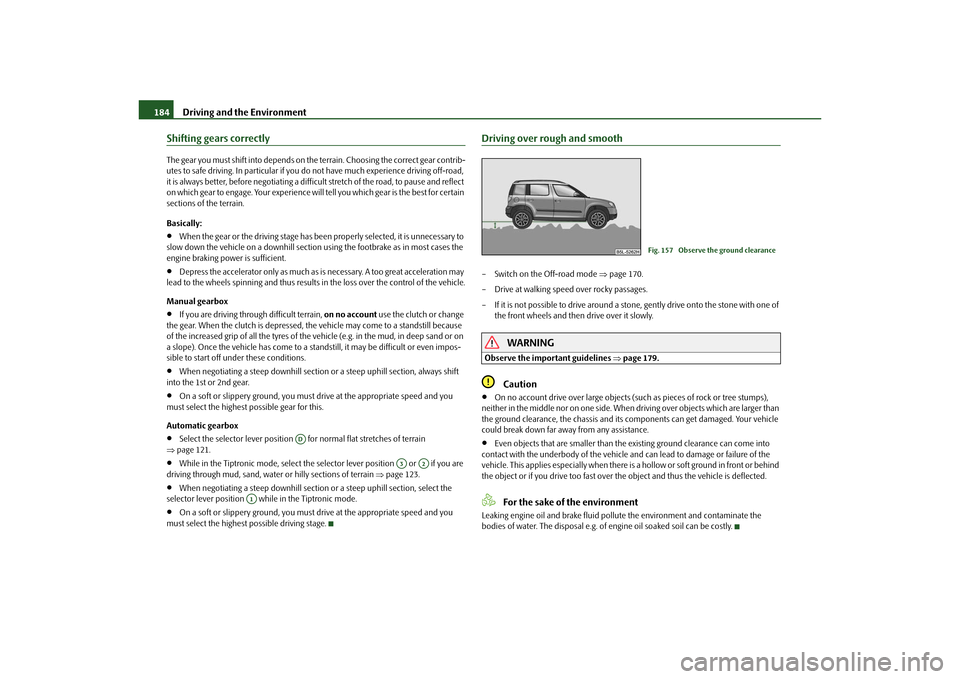
Driving and the Environment
184
Shifting gears correctlyThe gear you must shift into depends on th e terrain. Choosing the correct gear contrib-
utes to safe driving. In partic ular if you do not have much experience driving off-road,
it is always better, before negotiating a difficult stretch of the road, to pause and reflect
on which gear to engage. Your experience will tell you which gear is the best for certain
sections of the terrain.
Basically:
When the gear or the driving stage has been properly selected, it is unnecessary to
slow down the vehicle on a downhill sectio n using the footbrake as in most cases the
engine braking power is sufficient.
Depress the accelerator only as much as is necessary. A too great acceleration may
lead to the wheels spinning and thus results in the loss over the control of the vehicle.
Manual gearbox
If you are driving thro ugh difficult terrain, on no account use the clutch or change
the gear. When the clutch is depressed, th e vehicle may come to a standstill because
of the increased grip of all the tyres of the vehicle (e.g. in the mud, in deep sand or on
a slope). Once the vehicle has come to a stan dstill, it may be difficult or even impos-
sible to start off under these conditions.
When negotiating a steep downhill section or a steep uphill section, always shift
into the 1st or 2nd gear.
On a soft or slippery ground, you must drive at the appropriate speed and you
must select the highest possible gear for this.
Automatic gearbox
Select the selector lever position for normal flat stretches of terrain
page 121.
While in the Tiptronic mode, select the se lector lever position or if you are
driving through mud, sand, water or hilly sections of terrain page 123.
When negotiating a steep downhill section or a steep uphill section, select the
selector lever position while in the Tiptronic mode.
On a soft or slippery ground, you must drive at the appropriate speed and you
must select the highest possible driving stage.
Driving over rough and smooth– Switch on the Off-road mode page 170.
– Drive at walking speed over rocky passages.
– If it is not possible to drive around a stone, gently drive onto the stone with one of the front wheels and then drive over it slowly.
WARNING
Observe the important guidelines page 179.
Caution
On no account drive over large objects (suc h as pieces of rock or tree stumps),
neither in the middle nor on one side. When driving over objects which are larger than
the ground clearance, the chassis and its components can get damaged. Your vehicle
could break down far away from any assistance.
Even objects that are smaller than the existing ground clearance can come into
contact with the underbody of the vehicle an d can lead to damage or failure of the
vehicle. This applies especially when there is a hollow or soft ground in front or behind
the object or if you drive too fast over the object and thus the vehicle is deflected.For the sake of the environment
Leaking engine oil and brake fluid poll ute the environment and contaminate the
bodies of water. The disposal e.g. of engine oil soaked soil can be costly.
AD
A3
A2
A1
Fig. 157 Observe the ground clearance
s2ug.6.book Page 184 Friday, April 9, 2010 2:24 PM
Page 189 of 271
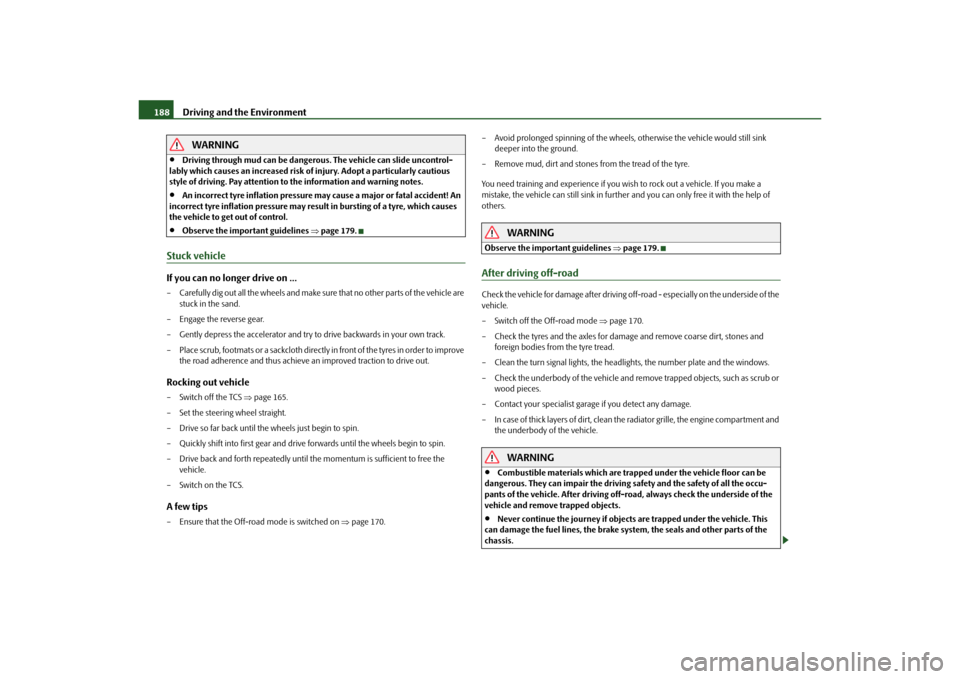
Driving and the Environment
188WARNING
Driving through mud can be dangerous. The vehicle can slide uncontrol-
lably which causes an increased risk of injury. Adopt a particularly cautious
style of driving. Pay attention to the information and warning notes.
An incorrect tyre inflation pressure may cause a major or fatal accident! An
incorrect tyre inflation pressure may result in bursting of a tyre, which causes
the vehicle to get out of control.
Observe the important guidelines page 179.
Stuck vehicleIf you can no longer drive on ...– Carefully dig out all the wheels and make sure that no other parts of the vehicle are
stuck in the sand.
– Engage the reverse gear.
– Gently depress the accelerator and try to drive backwards in your own track.
– Place scrub, footmats or a sackcloth directly in front of the tyres in order to improve
the road adherence and thus achieve an improved traction to drive out.Rocking out vehicle–Switch off the TCS page 165.
– Set the steering wheel straight.
– Drive so far back until the wheels just begin to spin.
– Quickly shift into first gear and drive forwards until the wheels begin to spin.
– Drive back and forth repeatedly until the momentum is sufficient to free the vehicle.
–Switch on the TCS.A few tips– Ensure that the Off-road mode is switched on page 170. – Avoid prolonged spinning of the wheels, otherwise the vehicle would still sink
deeper into the ground.
– Remove mud, dirt and stones from the tread of the tyre.
You need training and experience if you wish to rock out a vehicle. If you make a
mistake, the vehicle can still sink in further and you can only free it with the help of
others.
WARNING
Observe the important guidelines page 179.After driving off-roadCheck the vehicle for damage after driving off-road - especially on the underside of the
vehicle.
– Switch off the Off-road mode page 170.
– Check the tyres and the axles for damage and remove coarse dirt, stones and foreign bodies from the tyre tread.
– Clean the turn signal lights, the headlights, the number plate and the windows.
– Check the underbody of the vehicle and remove trapped objects, such as scrub or wood pieces.
– Contact your specialist gara ge if you detect any damage.
– In case of thick layers of dirt, clean the radiator grille, the engine compartment and the underbody of the vehicle.
WARNING
Combustible materials which are tra pped under the vehicle floor can be
dangerous. They can impair the driving safety and the safety of all the occu-
pants of the vehicle. After driving off-road, always check the underside of the
vehicle and remove trapped objects.
Never continue the journey if objects are trapped under the vehicle. This
can damage the fuel lines, the brake system, the seals and other parts of the
chassis.
s2ug.6.book Page 188 Friday, April 9, 2010 2:24 PM
Page 197 of 271
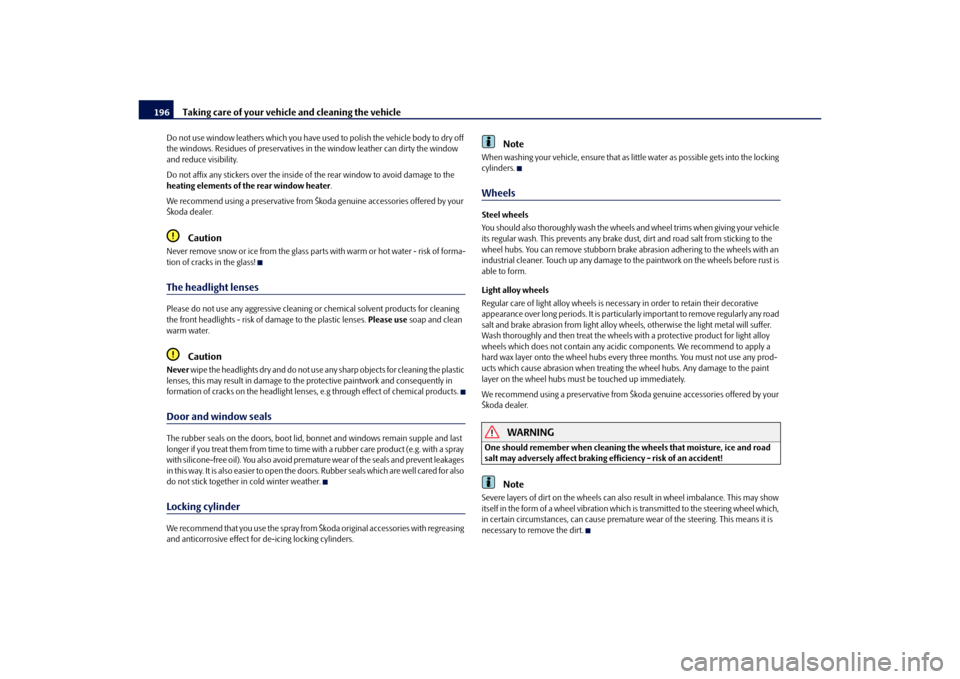
Taking care of your vehicle and cleaning the vehicle
196
Do not use window leathers which you have us ed to polish the vehicle body to dry off
the windows. Residues of preservatives in the window leather can dirty the window
and reduce visibility.
Do not affix any stickers over the inside of the rear window to avoid damage to the
heating elements of the rear window heater .
We recommend using a preserva tive from Škoda genuine accessories offered by your
Škoda dealer.
Caution
Never remove snow or ice from the glass parts with warm or hot water - risk of forma-
tion of cracks in the glass!The headlight lensesPlease do not use any aggressi ve cleaning or chemical solvent products for cleaning
the front headlights - risk of damage to the plastic lenses. Please use soap and clean
warm water.
Caution
Never wipe the headlights dry and do not use any sharp objects for cleaning the plastic
lenses, this may result in damage to the protective paintwork and consequently in
formation of cracks on the headlight lenses, e.g through effect of chemical products.Door and window sealsThe rubber seals on the doors, boot lid, bonnet and windows remain supple and last
longer if you treat them from time to time with a rubber care product (e.g. with a spray
with silicone-free oil). You also avoid premature wear of the seals and prevent leakages
in this way. It is also easier to open the doors. Rubber seals which are well cared for also
do not stick together in cold winter weather.Locking cylinderWe recommend that you use the spray from Škoda original accessories with regreasing
and anticorrosive effect for de-icing locking cylinders.
Note
When washing your vehicle, ensure that as little water as possible gets into the locking
cylinders.WheelsSteel wheels
You should also thoroughly wash the wheels and wheel trims when giving your vehicle
its regular wash. This prevents any brake dust, dirt and road salt from sticking to the
wheel hubs. You can remove stubborn brake abrasion adhering to the wheels with an
industrial cleaner. Touch up any damage to the paintwork on the wheels before rust is
able to form.
Light alloy wheels
Regular care of light alloy wh eels is necessary in order to retain their decorative
appearance over long periods. It is particul arly important to remove regularly any road
salt and brake abrasion from light alloy wheels, otherwise the light metal will suffer.
Wash thoroughly and then treat the wheels with a protective product for light alloy
wheels which does not cont ain any acidic components. We recommend to apply a
hard wax layer onto the wheel hubs every three months. You must not use any prod-
ucts which cause abrasion when treating the wheel hubs. Any damage to the paint
layer on the wheel hubs must be touched up immediately.
We recommend using a preservative from Šk oda genuine accessories offered by your
Škoda dealer.
WARNING
One should remember when cleaning th e wheels that moisture, ice and road
salt may adversely affect braking ef ficiency - risk of an accident!
Note
Severe layers of dirt on the wheels can also result in wheel imbalance. This may show
itself in the form of a wheel vibration which is transmitted to the steering wheel which,
in certain circumstances, can cause premature wear of the steering. This means it is
necessary to remove the dirt.
s2ug.6.book Page 196 Friday, April 9, 2010 2:24 PM
Page 202 of 271
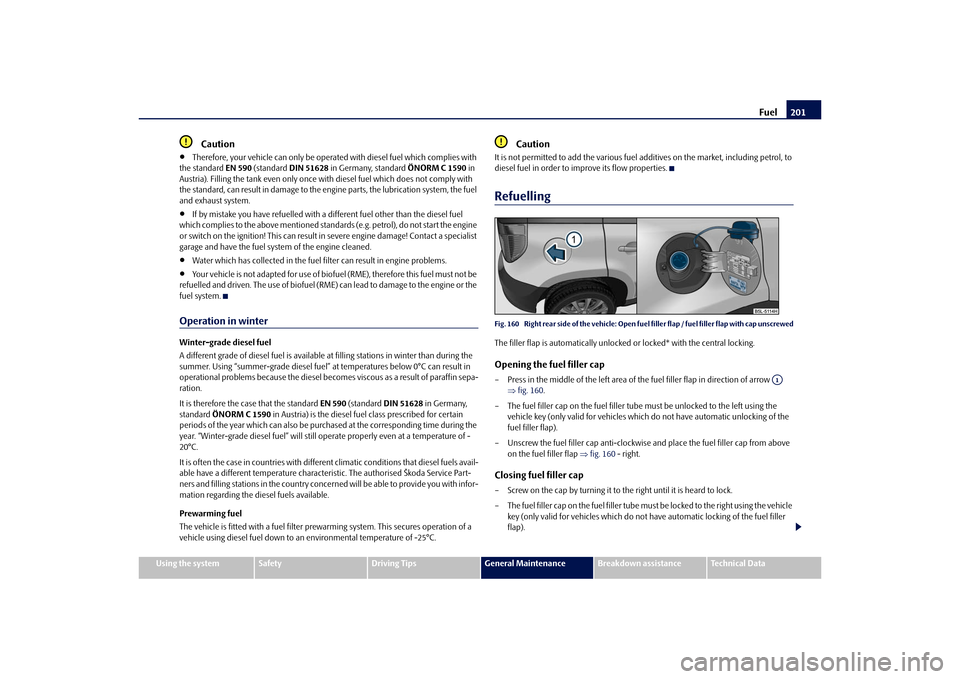
Fuel201
Using the system
Safety
Driving Tips
General Maintenance
Breakdown assistance
Technical Data
Caution
Therefore, your vehicle can only be operated with diesel fuel which complies with
the standard EN 590 (standard DIN 51628 in Germany, standard ÖNORM C 1590 in
Austria). Filling the tank even only once wi th diesel fuel which does not comply with
the standard, can result in damage to the engine parts, the lubrication system, the fuel
and exhaust system.
If by mistake you have refuelled with a different fuel other than the diesel fuel
which complies to the above mentioned standards (e.g. petrol), do not start the engine
or switch on the ignition! This can result in severe engine damage! Contact a specialist
garage and have the fuel sy stem of the engine cleaned.
Water which has collected in the fuel fi lter can result in engine problems.
Your vehicle is not adapted for use of biofue l (RME), therefore this fuel must not be
refuelled and driven. The use of biofuel (RME) can lead to damage to the engine or the
fuel system.
Operation in winterWinter-grade diesel fuel
A different grade of diesel fuel is available at filling stations in winter than during the
summer. Using “summer-grade diesel fuel” at temperatures below 0°C can result in
operational problems because th e diesel becomes viscous as a result of paraffin sepa-
ration.
It is therefore the case that the standard EN 590 (standard DIN 51628 in Germany,
standard ÖNORM C 1590 in Austria) is the diesel fuel class prescribed for certain
periods of the year which can also be purc hased at the corresponding time during the
year. “Winter-grade diesel fuel” will still operate properly even at a temperature of -
20°C.
It is often the case in countries with different climatic conditions that diesel fuels avail-
able have a different temperature characteristic. The authorised Škoda Service Part-
ners and filling stations in the country concer ned will be able to provide you with infor-
mation regarding the diesel fuels available.
Prewarming fuel
The vehicle is fitted with a fuel filter prewarming system. This secures operation of a
vehicle using diesel fuel down to an environmental temperature of -25°C.
Caution
It is not permitted to add the various fuel additives on the market, including petrol, to
diesel fuel in order to improve its flow properties.RefuellingFig. 160 Right rear side of the ve hicle: Open fuel filler flap / fuel filler flap with cap unscrewedThe filler flap is automatically unlocked or locked* with the central locking.Opening the fuel filler cap– Press in the middle of the left area of the fuel filler flap in direction of arrow
fig. 160 .
– The fuel filler cap on the fuel filler tube must be unlocked to the left using the
vehicle key (only valid for vehicles which do not have automatic unlocking of the
fuel filler flap).
– Unscrew the fuel filler ca p anti-clockwise and place the fuel filler cap from above
on the fuel filler flap fig. 160 - right.Closing fuel filler cap– Screw on the cap by turning it to the right until it is heard to lock.
– The fuel filler cap on the fuel filler tube must be locked to the right using the vehicle
key (only valid for vehicles which do not have automatic locking of the fuel filler
flap).
A1
s2ug.6.book Page 201 Friday, April 9, 2010 2:24 PM
Page 221 of 271
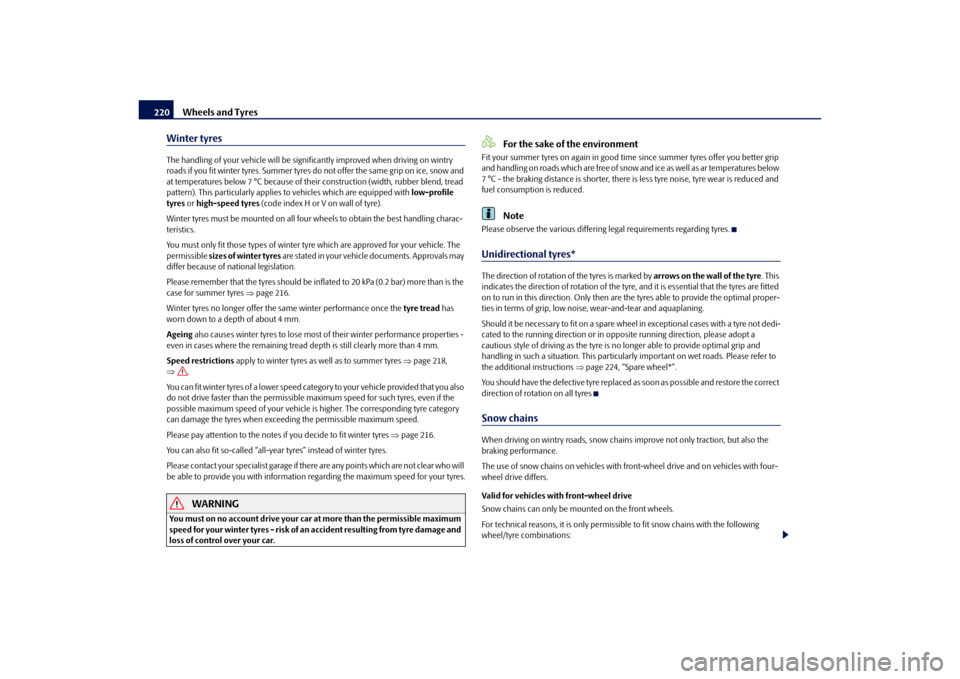
Wheels and Tyres
220
Winter tyresThe handling of your vehicl e will be significantly improved when driving on wintry
roads if you fit winter tyres. Summer tyres do not offer the same grip on ice, snow and
at temperatures below 7 °C because of thei r construction (width, rubber blend, tread
pattern). This particularly applies to vehicles which are equipped with low-profile
tyres or high-speed tyres (code index H or V on wall of tyre).
Winter tyres must be mounted on all four wheels to obtain the best handling charac-
teristics.
You must only fit those types of winter tyre which are approved for your vehicle. The
permissible sizes of winter tyres are stated in your vehicle documents. Approvals may
differ because of na tional legislation.
Please remember that the tyres should be inflated to 20 kPa (0.2 bar) more than is the
case for summer tyres page 216.
Winter tyres no longer offer the same winter performance once the tyre tread has
worn down to a depth of about 4 mm.
Ageing also causes winter tyres to lose most of their winter performance properties -
even in cases where the remaining tread depth is still clearly more than 4 mm.
Speed restrictions apply to winter tyres as well as to summer tyres page 218,
.
You can fit winter tyres of a lower speed catego ry to your vehicle provided that you also
do not drive faster than the permissible maximum speed for such tyres, even if the
possible maximum speed of your vehicle is higher. The corresponding tyre category
can damage the tyres when exceeding the permissible maximum speed.
Please pay attention to the notes if you decide to fit winter tyres page 216.
You can also fit so-called “all-year tyres” instead of winter tyres.
Please contact your specialist garage if there are any points which are not clear who will
be able to provide you with information regarding the maximum speed for your tyres.
WARNING
You must on no account drive your car at more than the permissible maximum
speed for your winter tyres - risk of an accident resulting from tyre damage and
loss of control over your car.
For the sake of the environment
Fit your summer tyres on again in good time since summer tyres offer you better grip
and handling on roads which are free of snow and ice as well as ar temperatures below
7 °C - the braking distance is shorter, there is less tyre noise, tyre wear is reduced and
fuel consumption is reduced.
Note
Please observe the various differing legal requirements regarding tyres.Unidirectional tyres*The direction of rotation of the tyres is marked by arrows on the wall of the tyre. This
indicates the direction of rotation of the tyre, and it is essential that the tyres are fitted
on to run in this direction. Only then are the tyres able to provide the optimal proper-
ties in terms of grip, low nois e, wear-and-tear and aquaplaning.
Should it be necessary to fit on a spare wheel in exceptional cases with a tyre not dedi-
cated to the running direction or in oppo site running direction, please adopt a
cautious style of driving as the tyre is no longer able to provide optimal grip and
handling in such a situation. This particular ly important on wet roads. Please refer to
the additional instructions page 224, “Spare wheel*”.
You should have the defective tyre replaced as soon as possible and restore the correct
direction of rotation on all tyresSnow chainsWhen driving on wintry roads, snow chains improve not only traction, but also the
braking performance.
The use of snow chains on ve hicles with front-wheel drive and on vehicles with four-
wheel drive differs.
Valid for vehicles with front-wheel drive
Snow chains can only be mounted on the front wheels.
For technical reasons, it is only permissible to fit snow chains with the following
wheel/tyre combinations:
s2ug.6.book Page 220 Friday, April 9, 2010 2:24 PM
Page 223 of 271
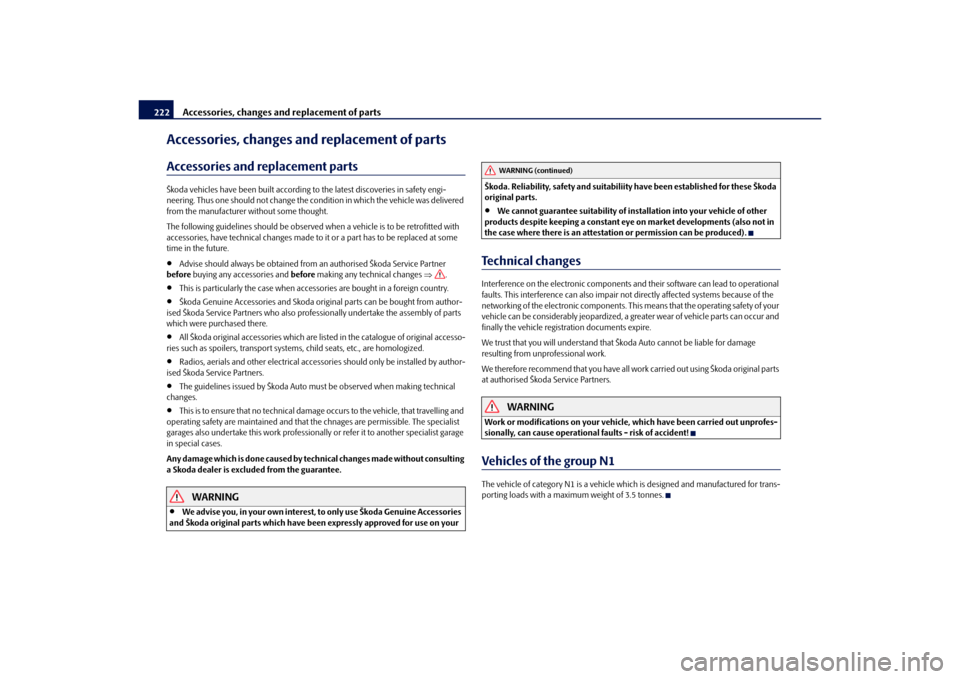
Accessories, changes and replacement of parts
222
Accessories, changes and replacement of partsAccessories and re placement partsŠkoda vehicles have been built according to the latest discoveries in safety engi-
neering. Thus one should not change the co ndition in which the vehicle was delivered
from the manufacturer without some thought.
The following guidelines should be observed when a vehicle is to be retrofitted with
accessories, have technical ch anges made to it or a part has to be replaced at some
time in the future.
Advise should always be obtained from an authorised Škoda Service Partner
before buying any accessories and before making any technical changes .
This is particularly the case when acce ssories are bought in a foreign country.
Škoda Genuine Accessories and Skoda origin al parts can be bought from author-
ised Škoda Service Partners who also professionally undertake the assembly of parts
which were purchased there.
All Škoda original accessories which are listed in the catalogue of original accesso-
ries such as spoilers, transport systems, child seats, etc., are homologized.
Radios, aerials and other electrical accessories should only be installed by author-
ised Škoda Service Partners.
The guidelines issued by Škoda Auto must be observed when making technical
changes.
This is to ensure that no technical damage occurs to the vehicle, that travelling and
operating safety are maintained and that the chnages are permissible. The specialist
garages also undertake this work professionally or refer it to another specialist garage
in special cases.
Any damage which is done caused by tech nical changes made without consulting
a Skoda dealer is exclud ed from the guarantee.
WARNING
We advise you, in your own interest, to only use Škoda Genuine Accessories
and Škoda original parts which have been expressly approved for use on your Škoda. Reliability, safety and suitabilii
ty have been established for these Škoda
original parts.
We cannot guarantee suitability of installation into your vehicle of other
products despite keeping a constant eye on market developments (also not in
the case where there is an attestation or permission can be produced).
Technical changesInterference on the electronic components and their software can lead to operational
faults. This interference can also impair no t directly affected systems because of the
networking of the electronic components. This means that the operating safety of your
vehicle can be considerably jeopardized, a greater wear of vehicle parts can occur and
finally the vehicle registration documents expire.
We trust that you will understand that Šk oda Auto cannot be liable for damage
resulting from unprofessional work.
We therefore recommend that you have all work carried out using Škoda original parts
at authorised Škoda Service Partners.
WARNING
Work or modifications on your vehicle, which have been carried out unprofes-
sionally, can cause operational faults - risk of accident!Vehicles of the group N1The vehicle of category N1 is a vehicle wh ich is designed and manufactured for trans-
porting loads with a maximum weight of 3.5 tonnes.
WARNING (continued)
s2ug.6.book Page 222 Friday, April 9, 2010 2:24 PM
Page 224 of 271
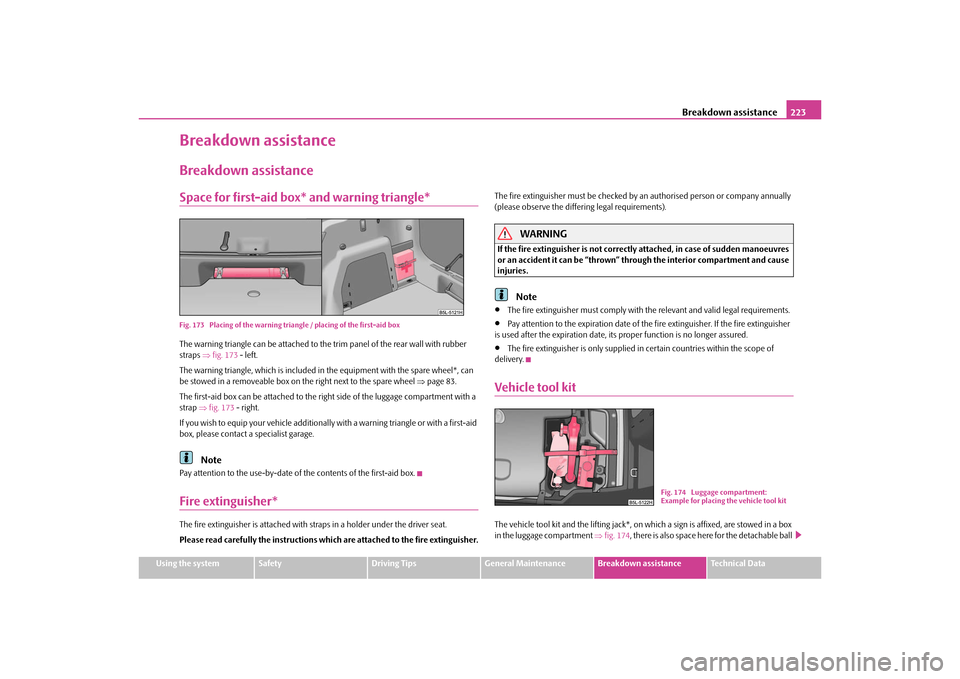
Breakdown assistance223
Using the system
Safety
Driving Tips
General Maintenance
Breakdown assistance
Technical Data
Breakdown assistanceBreakdown assistanceSpace for first-aid box* and warning triangle*Fig. 173 Placing of the warning triangle / placing of the first-aid boxThe warning triangle can be attached to th e trim panel of the rear wall with rubber
straps fig. 173 - left.
The warning triangle, which is included in the equipment with the spare wheel*, can
be stowed in a removeable box on the right next to the spare wheel page 83.
The first-aid box can be attached to the ri ght side of the luggage compartment with a
strap fig. 173 - right.
If you wish to equip your vehi cle additionally with a warning triangle or with a first-aid
box, please contact a specialist garage.
Note
Pay attention to the use-by-date of the contents of the first-aid box.Fire extinguisher*The fire extinguisher is attached with st raps in a holder under the driver seat.
Please read carefully the instructions whic h are attached to the fire extinguisher. The fire extinguisher must be checked by
an authorised person or company annually
(please observe the differing legal requirements).
WARNING
If the fire extinguisher is not correctly attached, in case of sudden manoeuvres
or an accident it can be “thrown” through the interior compartment and cause
injuries.
Note
The fire extinguisher must comply with the relevant and valid legal requirements.
Pay attention to the expiration date of the fire extinguisher. If the fire extinguisher
is used after the expiration date, its proper function is no longer assured.
The fire extinguisher is only supplied in certain countries within the scope of
delivery.
Vehicle tool kitThe vehicle tool kit and the lifting jack*, on which a sign is affixed, are stowed in a box
in the luggage compartment fig. 174 , there is also space here for the detachable ball
Fig. 174 Luggage compartment:
Example for placing the vehicle tool kit
s2ug.6.book Page 223 Friday, April 9, 2010 2:24 PM
Page 234 of 271
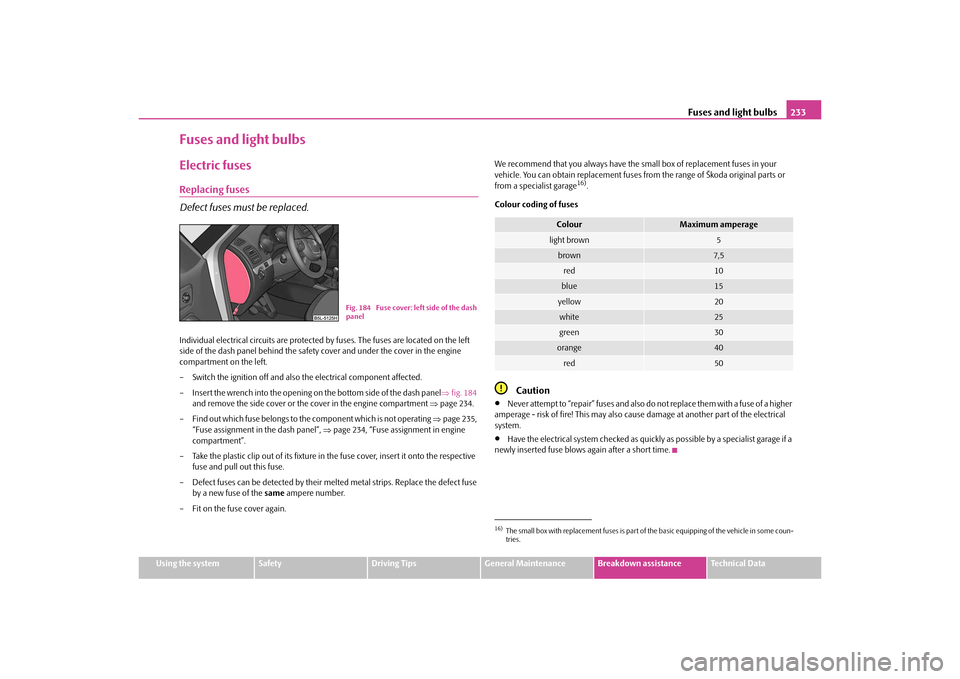
Fuses and light bulbs233
Using the system
Safety
Driving Tips
General Maintenance
Breakdown assistance
Technical Data
Fuses and light bulbsElectric fusesReplacing fuses
Defect fuses must be replaced.Individual electrical circuits are protected by fuses. The fuses are located on the left
side of the dash panel behind the safety cover and under the cover in the engine
compartment on the left.
– Switch the ignition off and also the electrical component affected.
– Insert the wrench into the opening on the bottom side of the dash panel fig. 184
and remove the side cover or the cover in the engine compartment page 234.
– Find out which fuse belongs to th e component which is not operating page 235,
“Fuse assignment in the dash panel”, page 234, “Fuse assignment in engine
compartment”.
– Take the plastic clip out of it s fixture in the fuse cover, insert it onto the respective
fuse and pull out this fuse.
– Defect fuses can be detected by their melted metal strips. Replace the defect fuse by a new fuse of the same ampere number.
– Fit on the fuse cover again. We recommend that you always have the
small box of replacement fuses in your
vehicle. You can obtain repl acement fuses from the range of Škoda original parts or
from a specialist garage
16).
Colour coding of fuses
Caution
Never attempt to “repair” fuses and also do not replace them with a fuse of a higher
amperage - risk of fire! This may also caus e damage at another part of the electrical
system.
Have the electrical system checked as quickly as possible by a specialist garage if a
newly inserted fuse blows again after a short time.
Fig. 184 Fuse cover: left side of the dash
panel
16)The small box with replacement fuses is part of the basic equipping of the vehicle in some coun-
tries.
Colour
Maximum amperage
light brown
5
brown
7,5
red
10
blue
15
yellow
20
white
25
green
30
orange
40
red
50
s2ug.6.book Page 233 Friday, April 9, 2010 2:24 PM